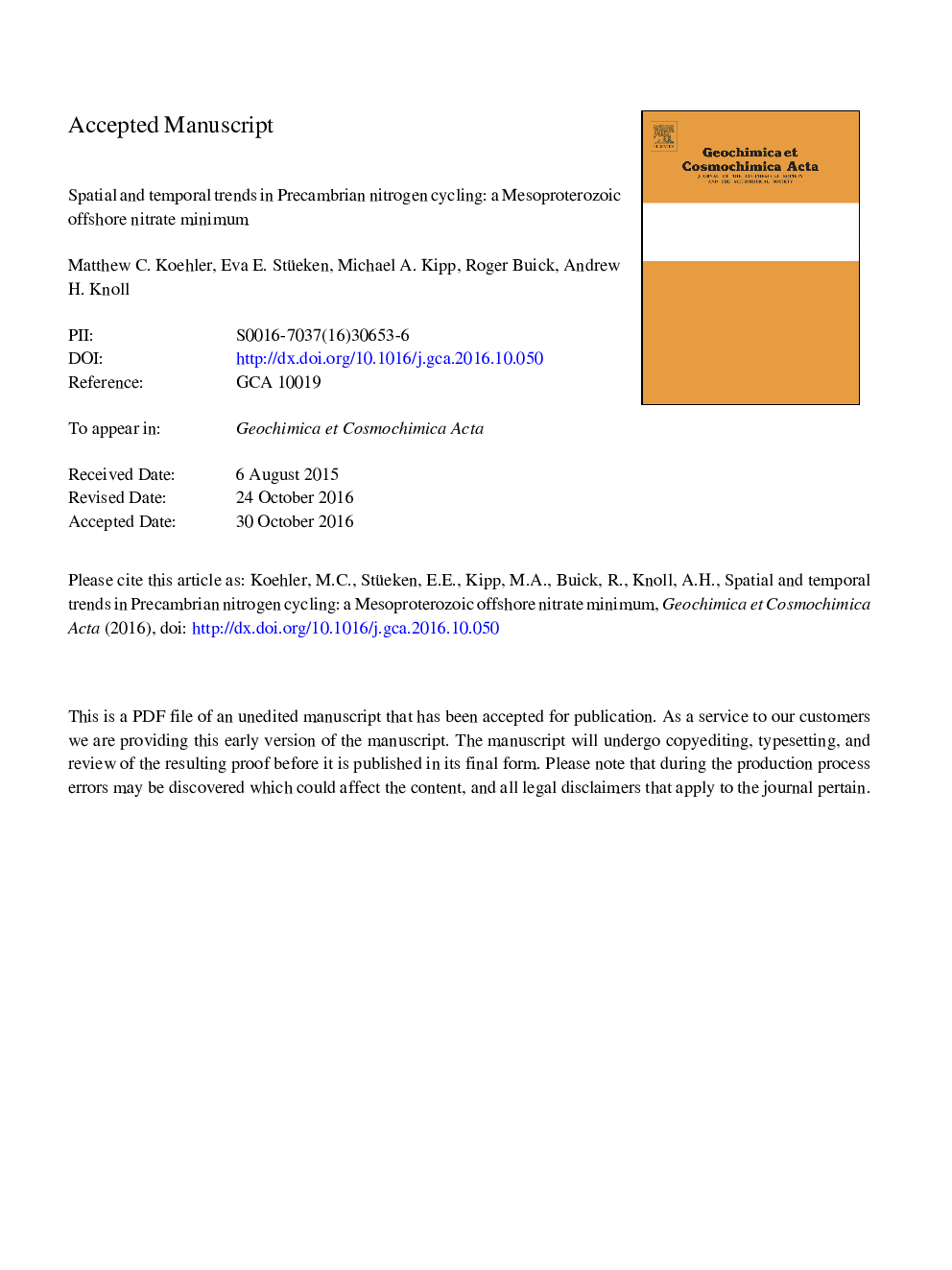| کد مقاله | کد نشریه | سال انتشار | مقاله انگلیسی | نسخه تمام متن |
|---|---|---|---|---|
| 5783633 | 1637959 | 2017 | 59 صفحه PDF | دانلود رایگان |
عنوان انگلیسی مقاله ISI
Spatial and temporal trends in Precambrian nitrogen cycling: A Mesoproterozoic offshore nitrate minimum
دانلود مقاله + سفارش ترجمه
دانلود مقاله ISI انگلیسی
رایگان برای ایرانیان
کلمات کلیدی
موضوعات مرتبط
مهندسی و علوم پایه
علوم زمین و سیارات
ژئوشیمی و پترولوژی
پیش نمایش صفحه اول مقاله

چکیده انگلیسی
Fixed nitrogen is an essential nutrient for eukaryotes. As N2 fixation and assimilation of nitrate are catalyzed by metalloenzymes, it has been hypothesized that in Mesoproterozoic oceans nitrate was limited in offshore environments by low trace metal concentrations and high rates of denitrification in anoxic and episodically euxinic deep water masses, restricting eukaryotes to near-shore environments and limiting their evolutionary innovation. To date this hypothesis has only been tested in the Belt Supergroup (â¼1.4 Ga), with results that support an onshore-offshore nitrate gradient as a potential control on eukaryote ecology. Here we present bulk nitrogen and organic carbon isotopic data from non-isochronous cross-basinal facies across the Bangemall (â¼1.5 Ga) and the Roper (â¼1.4-1.5 Ga) basins to better understand the extent and variability of onshore-offshore nitrogen isotope gradients in the Mesoproterozoic. Both basins show an average â¼1-2â° enrichment in δ15Nbulk from deep to shallow facies, with a maximum range from â1â° offshore to +7.5â° onshore. Unlike the Belt basin, the Bangemall and Roper basins show some offshore δ15Nbulk values that are enriched beyond the isotopic range associated with biological N2 fixation alone. This suggests a mixture of aerobic and anaerobic metabolisms offshore. In shallow waters, where δ15Nbulk enrichment peaks, an aerobic nitrogen cycle was evidently operating. Even though isotopic signatures of aerobic nitrogen cycling are seen in all parts of the Bangemall and Roper basins, our data are consistent with a lateral gradient in nitrate availability within the photic zone, with higher concentrations in near-shore environments than offshore. The variability in δ15Nbulk values in each depositional environment and the consistently low δ15Nbulk values from Mesoproterozoic units compared to the Paleoproterozoic and Neoproterozoic suggest that nitrate concentrations in the global ocean were likely low. This trend is now seen in all three Mesoproterozoic basins so far examined, and contrasts with the Paleoproterozoic and Neoproterozoic where nearly all δ15Nbulk data plot above the N2 fixation window. Thus, we propose that the Mesoproterozoic ocean was characterized by a nitrate minimum, with the lowest concentrations in offshore environments. This inference is consistent with a Mesoproterozoic O2 decline following a temporary Paleoproterozoic O2 peak, and it further supports the idea that nitrate limitation offshore may have contributed to the restriction of photosynthetic eukaryotes to near-shore environments, delaying their rise to ecological dominance until the Neoproterozoic Era.
ناشر
Database: Elsevier - ScienceDirect (ساینس دایرکت)
Journal: Geochimica et Cosmochimica Acta - Volume 198, 1 February 2017, Pages 315-337
Journal: Geochimica et Cosmochimica Acta - Volume 198, 1 February 2017, Pages 315-337
نویسندگان
Matthew C. Koehler, Eva E. Stüeken, Michael A. Kipp, Roger Buick, Andrew H. Knoll,